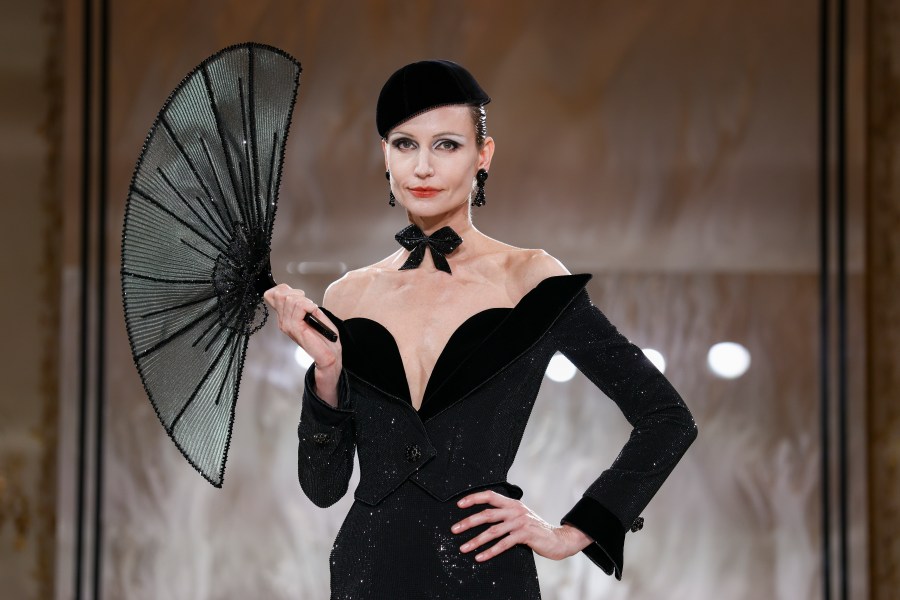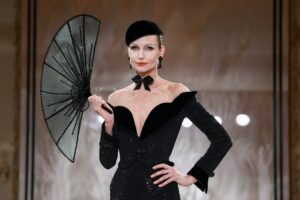
PARIS — Armani Privé opened its doors on Tuesday under an unmistakable shadow. For the first time in the 20-year history of his couture house, Giorgio Armani was not present in Paris to take his bow. Days shy of his 91st birthday, Armani followed doctors’ advice to oversee the Paris couture week show remotely from home, marking a poignant absence for a designer who has personally shaped every collection since the brand’s inception.
The show’s theme, “Seductive Black,” unfolded with both literal and symbolic force on the runway: black in myriad forms, from liquid velvet and lacquered silk to pavé crystals and flashes of gold. Even the models’ makeup adhered to the theme, rendered in shades of gray. For some in the front row, the relentless palette felt like a pointed message. Guests quietly speculated whether the choice of black was a coded communication from Armani himself.
Armani Misses Milan and Paris
This absence is not the first for Armani this season. Just weeks prior, he was unable to attend Milan Fashion Week for the first time in the label’s storied history, following a brief hospitalization. According to the brand, his absence was a precautionary measure to conserve energy for his anticipated Paris couture appearance. For decades, Armani — affectionately known as “Re Giorgio,” or King George, in Italy — has been both the creative and business force behind one of fashion’s last great independent empires.
The Tuesday collection balanced tension and control. After an uncertain start, featuring velvet jodhpurs and stark crystalline seams, Armani’s signature codes quickly emerged: tuxedo jackets transformed into evening gowns with plunging lapels and floating bow ties, tailored blazers worn on bare skin, and military-inspired equestrian jackets paired with slim velvet pants. Bursts of embroidery and colored feathers provided a counterpoint to the monochrome.
A Living Fashion Maestro
Armani’s recent absences have sent ripples through the fashion industry. In a landscape dominated by conglomerates like LVMH and Kering, Armani remains the sole shareholder of his company, personally overseeing every collection for nearly 50 years. In 2024, the Armani Group reported revenues of $2.5 billion, while Giorgio Armani’s personal fortune is estimated to be between $11–13 billion, even as the global luxury market faces various challenges.
“Armani is widely credited with redefining men’s and women’s tailoring, pioneering gender-fluidity in fashion, and inventing celebrity red-carpet dressing, from Julia Roberts to Cate Blanchett.”
Yet the designer himself has acknowledged that age is a reality he must contend with, and that pulling back might become a necessity. Whether the monochrome collection was a deliberate metaphor or simply a showcase of discipline, “Seductive Black” felt intensely personal — both a mood and a message, perhaps an understated nod to a master whose presence, even in absence, remains absolute.
The Future of Armani’s Legacy
As the show concluded, the final bow belonged to the models alone. Yet Armani’s vision — uncompromising and unmistakably his — filled the room. The absence of the maestro at such a pivotal moment raises questions about the future of his brand. Will Armani continue to be the guiding force behind his collections, or will he gradually pass the baton to a new generation?
Industry experts suggest that while Armani’s direct involvement might decrease, his influence will undoubtedly persist. As fashion evolves, the legacy of Giorgio Armani will likely adapt, reflecting both the designer’s enduring vision and the changing tides of the industry.
In the meantime, the fashion world watches and waits, eager to see how one of its last independent titans will navigate the challenges of time and succession. As the curtain falls on this chapter, the anticipation for what comes next is palpable, ensuring that Armani’s story is far from over.







